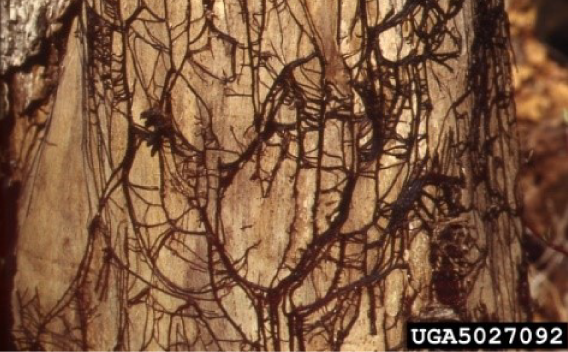Armillaria Root Disease
Armillaria (Armillaria spp.) root disease is a fungal infection that is widely distributed throughout the range of tree species and herbaceous shrubs in Wisconsin. Hundreds of plant species are susceptible to Armillaria infection, particularly when under environmental stress. Both coniferous and hardwood species can be affected.
Impact
Armillaria root disease is commonly called shoestring root rot. It causes mortality by drying out the root systems of infected hosts until they become white in color and stringy in texture. The disease can be lethal or cause a slow decline over time, leading to reduced vigor and growth.
Trees that are under stress from insect infestation or environmental factors are particularly susceptible to mortality from Armillaria. In years where drought or overabundant moisture occurs, disease incidence can increase significantly.
Biology
Armillaria has several life stages: white mats of fungus under bark, dark-colored shoestrings (rhizomorphs) on stems and roots and mushrooms near host trees. The shoestring life stages vary from reddish-brown to black and can be a few inches to many feet long. The shoestring structures are responsible for the spread of the fungus underground, as they make vast networks that can travel from infected trees to surrounding trees.
In the fall, clusters of pale-yellow-mushrooms, commonly referred to as honey mushrooms, will form around the base of dead or dying trees and stumps. These mushrooms produce spores that are spread by wind or rain. Armillaria can live on dead and dying material but can also be parasitic if the tree is susceptible to infection while under stress. Armillaria is commonly found in stressed trees and trees with forest insect damage.
Identification
Trees infected with Armillaria exhibit reduced growth, small, stunted leaves/needles, dieback of twigs and branches and gradual or sudden death of single or groups of trees. Infected seedlings and saplings often have reduced root systems.
Disease can start with single tree mortality, leading to pockets of death when the fungus moves from the dead tree to surrounding trees. Armillaria rhizomorphs are known to expand about 2-4 feet a year in the soil.
Search for white fungal fans and shoestrings under the bark and mushrooms around the base of suspect trees to confirm the presence of Armillaria.
Prevention
Maintaining healthy forests and trees through proper management is the best method for reducing loss due to Armillaria root disease. Thinning stands helps prevent the buildup of large quantities of dead and dying material that Armillaria could colonize. The removal of stumps after a harvest, in combination with delaying planting for a few years can reduce tree planting losses.
Armillaria is present in all forest stands to some degree, and control of infection is not always realistic or necessary. The fungus is beneficial in some ways, as it serves as a natural recycler of nutrients in wooded ecosystems, breaking down woody material to be used by other organisms and increasing soil health.
Management
Eradication of Armillaria root disease is not practical or possible in forests. It is more realistic to reduce damage to acceptable levels through proper management and prevention. It is possible to select resistant tree and shrub varieties and promote species diversity to reduce damage within a stand. If Armillaria incidence is high, consider removing stumps during harvesting if practical.
The maintenance of tree vigor can be used to manage Armillaria infection. In stands with heavy infection, the removal of dead and dying trees will promote understory tree regeneration and reduce the fungal inoculum load and food source, increasing survival and growth of understory species. If you suspect an Armillaria infection in your trees, contact your local Forest Health Specialist for assistance.




